Cold Waves & Hot Waves Explained
Cold Waves & Hot Waves |
One of the most visible manifestations of climate change is the increased frequency of extreme events such as flash floods, monsoon floods, severe & prolonged cold waves and heat waves etc. We will delve deeply into the ideas of cold waves and hot waves in this article.
Relevance:
GS-1 Geography: Important Geophysical Phenomena such as earthquakes, Tsunami, Volcanic activity, cyclone etc.,; geographical features and their location-changes in critical geographical features (including water-bodies and ice-caps) and in flora and fauna and the effects of such changes.
GS3: Disaster Management
Cold Waves |
Introduction:
- Cold wave, heavy snowfall/rainfall, fog, snow storms etc. have emerged as major weather hazards in recent years affecting different parts of the country.
- The World Meteorological Organization (WMO) statements on global climate during the past few years indicate that the global temperatures are substantially unveiling variations during various seasons and have a large impact on environment, agriculture, health, livestock, livelihoods, socio-economy and other allied sectors of a country. The management of cold wave remains a challenge with a large number of deaths each year especially in developing countries which lack proper heating systems.
- Around the world, many countries that experience cold wave as a recurrent hazard have developed institutional measures to prepare, mitigate, and respond to cold waves.
- In recent years, occurrences of extreme low temperature in association with incursion of dry, cold winds from north into the sub-continent are known as cold waves and cause discomfort, illnesses and even loss of lives.
- Cold wave occurs in the month of December-January every year and sometimes extended cold wave events occur from November to February and are limited mostly to northern India. The cold weather is marked by a well-defined and prolonged period of lower temperatures.
- The precise criterion for a cold wave is determined by the rate at which the temperature falls and the minimum to which it falls. This minimum temperature is dependent on the geographical region and time of the year.
- Cold wave is a localised seasonal phenomenon prevalent in the country except in southern India. The northern parts of India, specially the hilly regions (Jammu and Kashmir, Himachal Pradesh, Uttarakhand) and the adjoining plains are influenced by transient disturbances in the mid latitude westerlies which often have weak frontal characteristics. States like Punjab, Haryana, Rajasthan, Delhi, U.P., Bihar and Jharkhand are the highly affected from cold wave.
- The Core Cold Wave Zone covers 17 States/UTs The total population is 90.90 crors residing in those core cold wave zones.
- Some met subdivisions of Marathawada, Vidharbha, Saurashtra and Madhya Maharashtra are also affected by cold waves.
Damage Profile of Cold Waves:
- The extent of damage caused by a cold wave depends on the temperature, length of exposure, humidity levels, and the wind speed at freezing temperature.
- Cold waves have significant effects on health. In India, cold waves have caused 4,712 deaths from 2001 to 2019 across various states.
- IITM data shows increasing trends of cold waves from the last three decades (1991-2019).
- There was significant damage to crops, horticulture, forest trees, livestock, fisheries, water supply, power supply, transportation, tourism, social activities, economy and other livelihood systems in these regions that led to significant economic losses to the farming community. Cold wave also causes the death of wild animals, birds, poultry, etc. across the country. Cold wave also affects various service sectors including vegetable vendors, rickshaw pullers, daily wage workers, and roadside kiosk operators etc.
- In 2019-20, Punjab, Haryana, Rajasthan, U.P. and Bihar were highly affected in terms of casualties from cold wave. This could have been due to lack of planning and inadequate shelters for the outdoor workers, farmers and livestock. With effective planning and interventions, such loss of life could have been easily avoided.
Climatology of Cold Wave:
- The minimum temperatures (Tmin) go down below 8°C over many parts of northern India during November to February months (Fig. 1a to d). December & January are the coldest months with Tmin below 6°C over most parts of northwest and below 8°C over the rest parts of northern India.
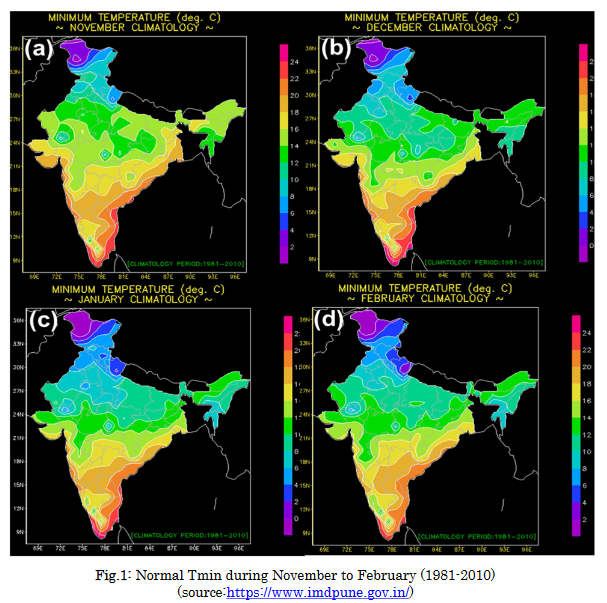
- Normally, in the winter months, after the passage of western disturbances, dry, cold north westerly winds make a way into north & central India. As a result, minimum temperatures drop over the regions and sometimes cause cold wave conditions.
- A cold wave is a meteorological event generally characterised by:
- the sharp drop of air temperature near the surface, leading to extremely low values;
- the steep rise of pressure;
- strengthening of wind speed; or
- associated with hazardous weather like frost and icing.
Cold Wave Season in India:
- Cold waves are seasonal with more episodes observed from November to March with each of these extreme events mostly experienced during the middle 3-month period.
- However, the minimum temperatures drop below 8°C over many parts of northern India during the months of November to February (December and January are the coldest months) over northern India with normal Tmin less than 8°C over its many parts.

The Major Factors for Cold Wave occurrence over India:
- A build-up of a ridge (an extended area of relatively high atmospheric pressure) in the jet stream over northwest Asia;
- Formation of surface high-pressure over north & central India;
- Movement of cold air masses in response to steering by upper-level winds;
- Triggering mechanism like a strong westerly wave approaching northwest India to enhance winds for transport cold air south eastward; and
- Extensive snow covers over northwest Himalayas.
Trend in Cold Wave:
- In general, scientists and policymakers across the globe are debating in the context of anthropogenic global warming which may lead to a decrease in the global occurrence of cold waves.
- However, instances of severe cold waves – in East Asia in 2016 or the recent cold wave in USA in 2021 gave rise to the discussion of cold waves occurring during the winter with the warmest recorded global mean Surface Air Temperature (SAT).
- While the East Asian cold wave is associated with atmospheric circulation regime, it mainly exhibited an extremely strong anomaly of the Ural Blocking High (UBH) and a record-breaking anomaly of the surface Siberian High (SH).
- However, because of the dynamic effect of Arctic amplification, anthropogenic global warming may increase the likelihood of extreme cold waves by shifting the responsible natural atmospheric circulation regime toward stronger amplitude. The probability of occurrence of extreme anomalies of UBH, SH, and East Asia mean SAT has been increased by 58%, 57%, and 32% respectively, as a consequence of anthropogenic global warming.
- During the cold-weather season (November to March), many stations from north, northwest, east and central India together named as Core Cold Wave Zone (CCZ) experienced the highest number of cold wave/severe cold wave with relatively higher frequency during December-January.
- Over India, the trend of the cold wave observed across 86 weather stations during the December-January-February season for the period 1971- 2020 is shown in Figure 4 above. It also shows falling/rising (blue/red arrows) trends in frequency of cold wave days in different parts of the country.
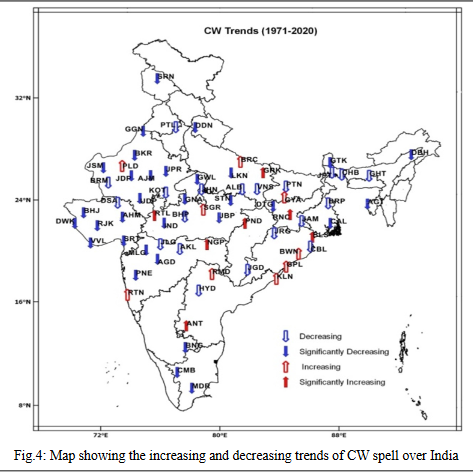
- The frequencies of the occurrence of cold waves in different parts of the country for different periods are shown in Table 1.
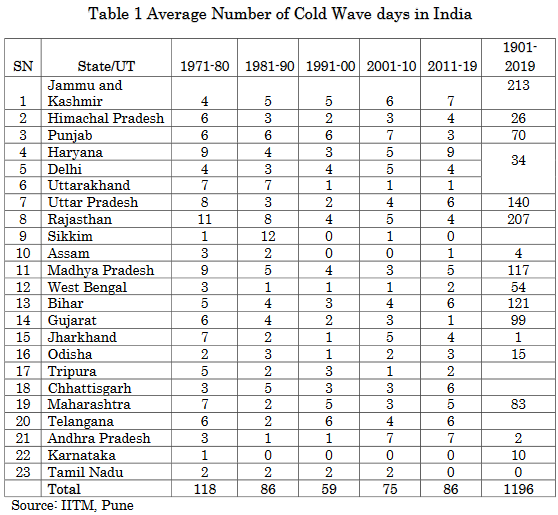
Impact of Cold Wave in India:
- Health:
- The impact of the cold wave on human beings can lead to death or injury. The mortality rates show a marked increase in areas with recurrent cold waves.
- Health issues are observed more commonly in the elderly and neonates.
- In India, cold wave has caused 4,712 deaths from 2001 to 2019 across various states.
- Agriculture:
- Cold wave and frost is a major factor that influences crop, horticultural plantations/orchard growth and productivity and has a significant impact on agriculture. As a result, the livelihood of people gets adversely affected.
- The extent of damage caused by a cold wave depends on temperature, length of exposure, humidity levels, and the speed at which freezing temperature is reached.
- Several crops and orchards in the north and north eastern regions of the country experienced the damaging effect of cold waves and frost.
- Low temperatures cause two types of injuries to plants.
- The first is chilling injury that occurs between 2°C and 0°C.
- The second type of injury is freezing injury, which occurs when the external temperature drops below the freezing point of water.
- Livestock:
- A cold wave can also cause death and injury to livestock. During a cold wave, the animals require a higher intake of nutrition which affects the hormonal level and efficiency of production.
- Often, if a cold wave is accompanied by heavy and persistent snow, grazing animals are unable to graze, hence requiring more fodder to be provided indoors. If the food is inadequate and there is exposure to low temperatures, animals may die of hypothermia or starvation. Similarly, wildlife also experiences challenges during winter for both shelter and food.
- Cold wave factors override genetic factors for determining the fertility patterns in buffaloes. The optimum breeding season for buffaloes under north Indian conditions is from October to February. Extreme variations in temperature as experienced during December and January may affect the fertility rate in cattle. Cold environment increases the body glucose turnover and glucose oxidation, thus resulting in less production of ketones.
- Fisheries:
- Extreme climatic conditions particularly in winter months when air temperature drops to 2-4°C and water temperature is between 10-15°C, adversely affects the growth of Indian major carps. The effect on overall health of stocked fishes may be more when such conditions prevail for a longer duration.
- Transport:
- Cold wave or extreme cold weather affects the transport sector such as airways, river & seaport, roadways, railways, local transport etc.
- Rivers and lakes also freeze during extreme cold conditions affecting waterways and the resulting intense fog can sometimes also lead to huge traffic jams, major accidents and delay which may cause health related complication and loss of educational/employment opportunity.
- Energy or power:
- Energy or power sector receives too much pressure during extreme winter or cold wave season. During the cold wave season, energy consumption rises significantly.
- In hilly regions, electricity is the main source of heating in houses. Other energy sources like fuel, oil, coal are also in great demand during the cold wave season.
- Water:
- Water sector is directly impacted by cold waves as it gets frozen due to extreme low temperature. Due to freezing, water supply may get disrupted.
- Other water dependent sectors will also be impacted if water supply gets disrupted. Other infrastructures are also impacted by cold wave conditions to varying degrees.
- Tourism:
- Tourism sector has both positive and negative impacts of cold weather. One the one hand, India receives a large number of tourists in the months of December and January in hilly States, but extreme cold may also result in less number of tourists as well as additional challenges for the State Government and local administration for their health and safety.
- Small street vendors:
- Small street vendors are highly affected due to exposure to cold waves and frost. This affects their livelihood and economy.
Definition of Cold Wave:
As per the India Meteorological Department’s criteria, Cold Wave and Cold Day conditions are defined as:
(A) Cold Wave: It should be based on the actual minimum temperature of a station. Cold Wave is considered when the minimum temperature of a station is 10°C or less for plains and 0°C or less for hilly regions.
- Based on Departure:
- Cold Wave (CW): Negative Departure (i.e. decline in the temperature) from normal is 4.5°C to 6.4°C
- Severe Cold Wave (SCW): Negative Departure from normal is more than 6.4°C
- Based on Actual Minimum Temperature (For plain stations only):
- Cold Wave: When the minimum temperature is ≤ 04°C
- Severe Cold Wave: When the minimum temperature is ≤ 02°C
- Cold Wave conditions for coastal stations:
- When minimum temperature departure is -4.5°C or less over a station,
- “Cold Wave” may be described if the minimum temperature is 15°C or less.
(B) Cold Day:
- It should be considered when minimum temperature is 10°C or less for plains and 0°C or less for hilly regions.
- Cold day: Maximum Temperature Departure is -4.5°C to -6.4°C
- Severe Cold day: Maximum Temperature Departure is < -6.4°C
Cold Waves – Hazards Analysis:
- Due to India’s vast geographical area, it is exposed to various kinds of natural hazards, viz., earthquakes, landslides, tsunamis, avalanches, GLOFs, floods, cold waves, wildfires, cyclones, etc.
- Cold waves are prominent in the northern parts of the country, along the Himalayas and western desert areas.
- In the current climate change regime, these weather-related events (like cold waves) are further aggravated.
- As per IMD, India’s ‘Core Cold Wave Zone’ covers 17 States/UTs total population residing in 17 states/UTs, falling under Core Cold wave Zone, is 90.90 crors. Out of this, 24.28 crore are either below 10 years or above 60years of age (Rural 17.9 Cr. and Urban 6.38Cr.), these people may be more vulnerable to cold waves. i.e Punjab, Himachal Pradesh, Uttarakhand, Jammu & Kashmir, Ladakh, Delhi, Haryana, Rajasthan, Uttar Pradesh, Gujarat, Madhya Pradesh, Chhattisgarh, Bihar, Jharkhand, West Bengal, Odisha and Telangana.
- The figure 6 shows the areas affected by CW and SCW.
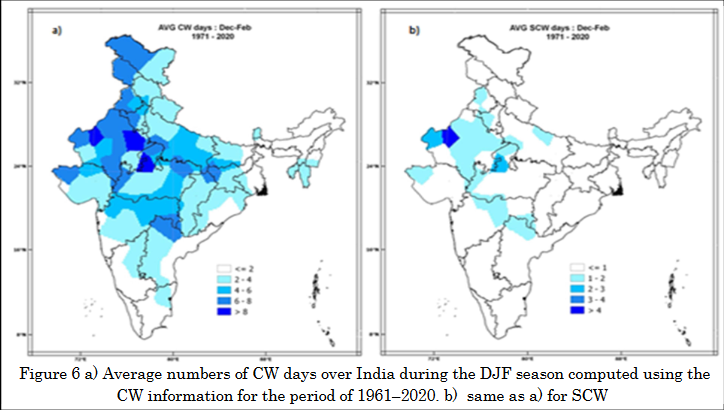
- The maximum numbers of cold waves occur in Jammu and Kashmir followed by Himachal Pradesh, Punjab, Bihar, Haryana and Uttar Pradesh. These State authorities within the CCZ may analyse the cold wave/severe cold wave durations and prepare SOPs to mitigate cold wave related negative impacts. IMD issues forecasts and warnings before the cold wave season starts.
Cold Waves – Vulnerability Analysis:
- The impact of hazard events such as cold waves, extreme cold waves, rainfall, snowfall, is substantial and represents an increasing threat over India.
- Table 2 shows the sectors and their vulnerability to cold wave and related hazards.
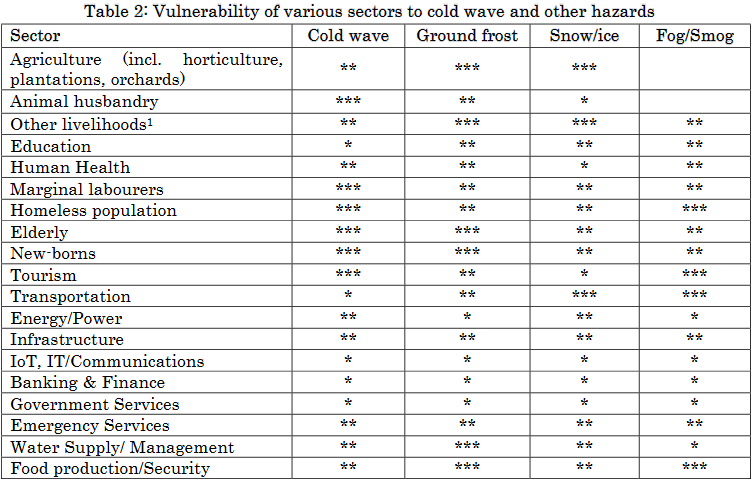
- When it comes to economic sectors that are vulnerable to cold wave and related hazards; agriculture, animal husbandry and health are of primary importance. Human health is also vulnerable to the temperature drop.
Dealing with Cold Wave – Cold Wave and Disaster Management:
- “Disaster” is defined under section 2(d) of the Disaster Management Act, 2005 as a catastrophe, mishap, calamity or grave occurrence in any area, arising from natural or man-made causes, and is of such a nature or magnitude as to be beyond the coping capacity of the affected area.
- Considering the importance of cold wave, the Government of India notified ‘cold wave’ as a disaster and the Ministry of Agriculture as the nodal Ministry for cold wave/ frost.
- Accordingly, the Ministry of Home Affairs included cold wave/ frost as an eligible natural calamity in the guidelines for relief assistance under the SDRF / NDRF, and the financial assistance is limited to the agriculture sector only.
- Cold Wave Action Plan (CWAP) is prepared by The National Disaster Management Authority (NDMA).
Heat Waves |
Introduction:
- Climate change is driving temperatures higher as well as increasing the frequency and severity of heat waves in India. In the past few years, India too is experiencing the impact of climate change in terms of increased instances of heat wave every year.
- According to the special report released by the Inter-govemmental Panel on Climate Change (IPCC) (October 2018), global warming of 1.5°C-2°C will worsen the situation in the cities where conditions comparable to the deadly 2015 heat wave (in 2015, nine states were affected due to heat waves.) are expected, along with unavoidable poverty and health risks that come with global warming. Deforestation and increasing constructed area are also adding to environmental instability and contributing to global warming and climate change.
- Heat wave has emerged as one of the major weather hazards in India. There has been an increasing trend of heat wave phenomenon in India over the past several years whereby several States/district/cities/towns in India have been severely affected. Consequently, than is an urgent need to evaluate impacts of the heat wave and plan adaptation and mitigation strategies for prevention, preparedness and community outreach to safeguard human lives, livestock and wild life.
- A large proportion of our population is highly vulnerable to heat waves due to the possession of fewer household amenities as well as lower rates of literacy and access to water and sanitation. In India, heat-wave caused 22,562 deaths between 1992 and 2015, five times the death toll from Hurricane Katrina that was hailed as a major, global-scale disaster.
- Apart from the high mortality rates observed, heat wave severely impacts our well-being. Aptly called a “silent disaster,” it has developed gradually and led to serious health concerns for humans, crops as well as livestock.
What is heat wave?
- Qualitatively, heat wave is a condition of air temperature which becomes fatal to human body when exposed. Quantitatively, it is defined based on the temperature thresholds over a region in terms of actual temperature or its departure from normal. In certain countries it is defined in term of the heat index based on temperature and humidity or based on extreme percentile of the temperatures.
What is criterion for declaring heat wave?
Heat wave is considered if maximum temperature of a station reaches at least 40°C or more for Plains and at least 30°Cor more for Hilly regions.
a) Based on Departure from Normal:
- Heat Wave: Departure from normal is 4.5°C to 6.4°C
- Severe Heat Wave: Departure from normal is >6.4°C
b) Based on Actual Maximum Temperature:
- Heat Wave: When actual maximum temperature ≥ 45°C
- Severe Heat Wave: When actual maximum temperature ≥47°C
If above criteria met at least in 2 stations in a Meteorological sub-division for at least two consecutive days and it declared on the second day.
What is a criterion for describing Heat Wave for coastal stations?
- When maximum temperature departure is 4.5°C or more from normal, Heat Wave may be described provided actual maximum temperature is 37°C or more.

What is warm night?
- It is considered only when maximum temperature remains 40°C or more. It is defined based on departures or actual minimum temperatures as follows:
- Warm night: minimum temperature departure is 4.5°C to 6.4°C
- Very warm night: minimum temperature departure is >6.4°C
What is the period of heat wave over India?
- It is occurring mainly during March to June and in some rare cases even in July. The peak month of the heat wave over India is May.
What are the heat wave prone states over India?
- Heat wave generally occurs over plains of northwest India, Central, East & north Peninsular India during March to June.
- It covers Punjab, Haryana, Delhi, Uttar Pradesh, Bihar, Jharkhand, WestnBengal, Odisha, Madhya Pradesh, Rajasthan, Gujarat, parts of Maharashtra & Karnataka, Andhra Pradesh and Telengana. Sometimes it occurs over Tamilnadu & Kerala also.
- Heat waves adversely affect human and animal lives. However, maximum temperatures more than 45°C observed mainly over Rajasthan and Vidarbha region in month of May.
How India Meteorological Department (IMD) monitors the Heat wave?
- IMD has a big network of surface observatories covering entire country to measure various metrological parameters like Temperature, Relative humidity, pressure, wind speed & direction etc. Based on daily maximum temperature station data, climatology of maximum temperature is prepared for the period 1981-2010 to find out normal maximum temperature of the day for particular station. Thereafter, IMD declared heat wave over the region as per its definition.
What are favorable conditions for Heat wave?
- Transportation / Prevalence of hot dry air over a region (There should be a region of warm dry air and appropriate flow pattern for transporting hot air over the region).
- Absence of moisture in the upper atmosphere (As the presence of moisture restricts the temperature rise).
- The sky should be practically cloudless (To allow maximum insulation over the region).
- Large amplitude anti-cyclonic flow over the area.
Heat waves generally develop over Northwest India and spread gradually eastwards & southwards but not westwards (since the prevailing winds during the season are westerly to northwesterly). But on some occasions, heat wave may also develop over any region in situ under the favorable conditions.

How heat discomfort is determined?
- It is determined by a combination of meteorological (temperature, Relative Humidity, wind, direct sunshine), social/cultural (clothing, occupation, accommodation) and physiological (health, fitness, age, level of acclimatization) factors.
What is heat index?
- The heat index is the combination of air temperature and relative humidity, it measure of how hot it really feels when relative humidity is factored in with the actual air temperature.
Health Impacts of Heat Waves?
The health impacts of Heat Waves typically involve dehydration, heat cramps, heat exhaustion and/or heat stroke. The signs and symptoms are as follows:
- Heat Cramps: Ederna (swelling) and Syncope (Fainting) generally accompanied by fever below 39°C i.e.102°F.
- Heat Exhaustion: Fatigue, weakness, dizziness, headache, nausea, vomiting, muscle cramps and sweating.
- Heat Stoke: Body temperatures of 40°C i.e. 104°F or more along with delirium, seizures or coma. This is a potential fatal condition
What is government's take on heat waves?
- The National Disaster Management Act, 2005, and the National Policy on Disaster Management, 2009, also don’t have heatwaves in the list of natural calamities though they are the third biggest natural cause of deaths.
- Heat waves were not notified as a disaster at the national level under the existing disaster relief policies. But, state governments were authorised to spend up to 10 per cent of funds under certain heads for heat wave relief.
- The NDMA has a Heat Action Plan that provides a framework to states for the implementation, coordination and evaluation of extreme heat-response activities. The plan outlines strategies such as establishing an early warning system; training health care professionals; improving community outreach to alert people; setting up temporary shelters, and improving water delivery systems.
Some infographics:




Recent Articles
- India-Canada Relations: A Comprehensive Analysis of History, Ups and Downs, and Current Challenges
- World Heritage Sites in India Under Threat: A Recent Overview
- 100 Most Important Topics for Prelims 2024
- Most Important Tribes in News 2024
- Most Important Index in News 2024
- Geography 2024 Prelims 365
- Government Schemes & Bodies 2024 Prelims 365
- Society 2024 Prelims 365
- Economy 2024 Prelims 365
- Polity 2024 Prelims 365
Popular Articles
- UPSC CSE 2023 Mains Essay Paper Model Answers
- UPSC CSE 2022 Mains GS 1 Paper Model Answers
- Storage, Transport & Marketing of Agricultural Produce & Issues & Related Constraints.
- Static Topics Repository for Mains
- Anti-Globalization Movement
- UPSC CSE 2023 Mains GS 1 Paper Model Answers
- UPSC CSE 2022 Mains GS 4 Paper Model Answers
- UPSC CSE 2023 Mains GS 2 Paper Model Answers
- PDS: objectives, functioning, limitations, revamping
- Achievements of Indians in Science & Technology




